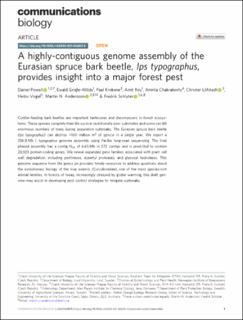| dc.contributor.author | Powell, Daniel | |
| dc.contributor.author | Groβe-Wilde, Ewald | |
| dc.contributor.author | Krokene, Paal | |
| dc.contributor.author | Roy, Amit | |
| dc.contributor.author | Chakraborty, Amrita | |
| dc.contributor.author | Löfstedt, Christer | |
| dc.contributor.author | Vogel, Heiko | |
| dc.contributor.author | Andersson, Martin N. | |
| dc.contributor.author | Schlyter, Fredrik | |
| dc.date.accessioned | 2021-11-04T09:22:30Z | |
| dc.date.available | 2021-11-04T09:22:30Z | |
| dc.date.created | 2021-10-04T10:59:15Z | |
| dc.date.issued | 2021-09-09 | |
| dc.identifier.citation | Communications Biology. 2021, 4 . | en_US |
| dc.identifier.issn | 2399-3642 | |
| dc.identifier.uri | https://hdl.handle.net/11250/2827792 | |
| dc.description.abstract | Conifer-feeding bark beetles are important herbivores and decomposers in forest ecosystems. These species complete their life cycle in nutritionally poor substrates and some can kill enormous numbers of trees during population outbreaks. The Eurasian spruce bark beetle (Ips typographus) can destroy >100 million m3 of spruce in a single year. We report a 236.8 Mb I. typographus genome assembly using PacBio long-read sequencing. The final phased assembly has a contig N50 of 6.65 Mb in 272 contigs and is predicted to contain 23,923 protein-coding genes. We reveal expanded gene families associated with plant cell wall degradation, including pectinases, aspartyl proteases, and glycosyl hydrolases. This genome sequence from the genus Ips provides timely resources to address questions about the evolutionary biology of the true weevils (Curculionidae), one of the most species-rich animal families. In forests of today, increasingly stressed by global warming, this draft genome may assist in developing pest control strategies to mitigate outbreaks. | en_US |
| dc.language.iso | eng | en_US |
| dc.publisher | Springer Nature | en_US |
| dc.rights | Navngivelse 4.0 Internasjonal | * |
| dc.rights.uri | http://creativecommons.org/licenses/by/4.0/deed.no | * |
| dc.title | A highly-contiguous genome assembly of the Eurasian spruce bark beetle, Ips typographus, provides insight into a major forest pest | en_US |
| dc.type | Peer reviewed | en_US |
| dc.type | Journal article | en_US |
| dc.description.version | publishedVersion | en_US |
| dc.rights.holder | © The Author(s) 2021 | en_US |
| dc.source.pagenumber | 9 | en_US |
| dc.source.volume | 4 | en_US |
| dc.source.journal | Communications Biology | en_US |
| dc.identifier.doi | 10.1038/s42003-021-02602-3 | |
| dc.identifier.cristin | 1942949 | |
| dc.relation.project | Norges forskningsråd: 249958 | en_US |
| dc.source.articlenumber | 1059 | en_US |
| cristin.ispublished | true | |
| cristin.fulltext | original | |
| cristin.qualitycode | 1 | |

